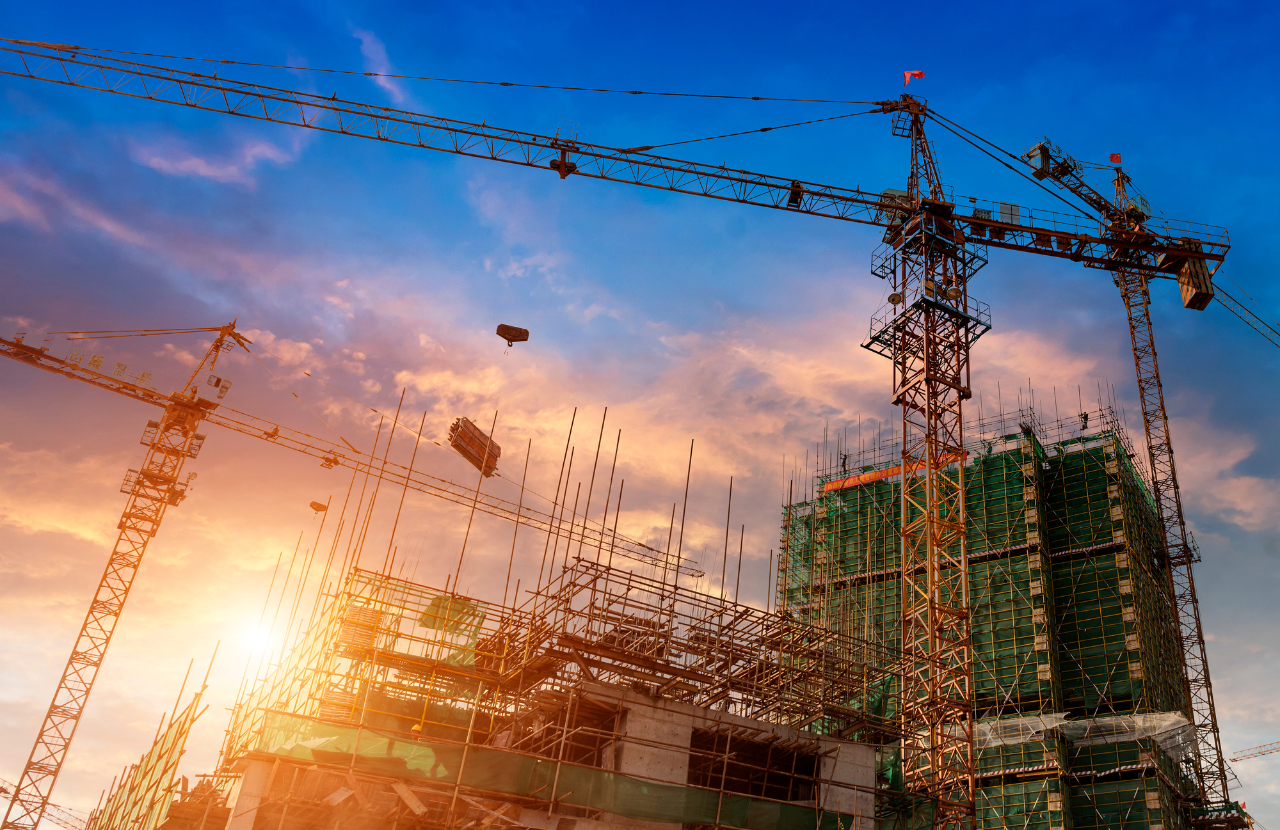
Understanding how to implement construction site health and safety is essential for preventing accidents. Strong safety management protects workers, supports productivity, reduces costs, and ensures compliance with health and safety laws.
The construction industry is one of the most high-risk sectors in the UK, where hazards such as working at height, moving machinery, and structural collapse are part of daily operations. According to the Health and Safety Executive (HSE), 35 construction workers lost their lives in 2024/25, the highest of any industry in Great Britain.
This guide explores the practical steps for implementing effective health and safety on a construction site and key legal requirements.
Step 1: Conduct a comprehensive risk assessment
The first step in implementing health and safety on a construction site is to identify potential hazards and assess the risks they pose.
Under the Management of Health and Safety at Work Regulations 1999, employers must record significant risks and state how they will be controlled.
A risk assessment should consider who might be harmed, how serious the harm could be, and what can be done to prevent it. Common construction hazards include:
- Working at height
- Slips, trips, and falls
- Moving vehicles and machinery
- Electrical hazards
- Hazardous materials such as asbestos, silica dust, and cement
- Manual handling and lifting
Once hazards are identified, control measures should be put in place following the hierarchy of control, starting with eliminating risks where possible and using PPE as a last resort. Controls might include planning work to avoid high-risk activities, using safer equipment, maintaining clear walkways, or providing training and supervision.
The findings should be recorded and communicated so that everyone on-site understands the risks and how they are managed. Risk assessments should also be reviewed regularly, especially when work changes or new hazards are introduced.
Step 2: Appoint competent duty holders
Under the CDM 2015, key duty holders must be appointed to plan, manage, and monitor health and safety throughout a construction project.
Each duty holder has defined responsibilities to ensure risks are properly managed at every stage. For example:
- The Client – must make suitable arrangements for managing the project before work starts. This includes allowing enough time and resources for the work to be carried out safely, appointing competent duty holders, and ensuring effective communication between all parties.
- The Principal Designer – takes the lead during the design phase. They must identify, eliminate, or control foreseeable risks and coordinate the flow of health and safety information between designers, the client, and contractors.
- The Principal Contractor – is responsible for day-to-day site safety during the construction phase. Their duties include preparing and implementing the Construction Phase Plan (see below), managing subcontractors, monitoring site conditions, and ensuring workers receive site inductions and relevant training.
Competence is a central requirement of CDM 2015. Anyone appointed as a duty holder must have the appropriate skills, knowledge, experience, and organisational capability to perform their role safely and effectively.
Step 3: Develop a construction phase plan
The Construction Phase Plan (CPP) sets out how health and safety risks will be managed on-site during the construction phase and ensures that everyone involved understands the arrangements in place to work safely.
A CPP should include:
- Site rules and induction procedures – detailing expected behaviours, site access arrangements, PPE requirements, and emergency contacts.
- Risk assessments and method statements (RAMS) – explaining how specific activities will be carried out safely and what controls are in place.
- Emergency arrangements – including fire safety, first aid, spill response, and evacuation procedures.
- Welfare provisions – ensuring adequate facilities such as toilets, washing areas, rest areas, and drinking water, as required by CDM 2015, Schedule 2.
- Roles and responsibilities – identifying who is responsible for each aspect of site management and supervision.
- Communication and supervision arrangements – explaining how information will be shared between workers, supervisors, and contractors, and how site safety will be monitored.
The CPP should be proportionate to the scale and complexity of the project. It must also be kept up to date as work progresses or if site conditions change.
Step 4: Provide information, instruction, and training
Under the Health and Safety at Work etc. Act 1974 and CDM 2015, employers and contractors must provide workers with the information, instruction, and training they need to carry out their work safely and competently.
Effective training helps workers recognise hazards, follow procedures, and take responsibility for their own safety and that of others. It should be tailored to the site, the nature of the work, and the experience of those involved.
Training and communication activities should include:
- Site induction – mandatory for everyone before they begin work. Inductions should cover site layout, emergency procedures, welfare facilities, and key safety rules.
- Toolbox talks – short, regular briefings that address specific risks or tasks, such as working at height or using new equipment.
- Task-specific training – for high-risk activities like scaffolding, confined space entry, lifting operations, or electrical work.
- Health and safety awareness training – on topics such as working at height, manual handling, asbestos awareness, fire safety, and use of PPE.
- Refresher training – to ensure ongoing competence and address any changes in procedures or legislation.
Information should also be provided in formats that all workers can understand, including translated materials or visual aids where necessary. Supervisors and managers must reinforce this information through consistent communication and example.
Step 5: Monitor, supervise, and review
Maintaining high health and safety standards on a construction site requires consistent monitoring, active supervision, and regular review. This ensures that planned safety measures are being followed effectively as site conditions and activities change.
Monitoring site safety
Under CDM 2015, the Principal Contractor is responsible for managing and monitoring health and safety throughout the construction phase. This involves carrying out routine inspections, ensuring workers follow safe systems of work, and checking that control measures remain suitable and effective as the project progresses.
Effective supervision
Supervisors play a crucial role in maintaining safety standards on-site. They observe daily activities, correct unsafe behaviours, and reinforce safety messages through leadership and example.
Regular site walkarounds, equipment checks, and briefings help identify emerging risks early and prevent incidents before they occur.
Reporting and investigation
All accidents, near misses, and unsafe conditions should be reported promptly and investigated to identify the root cause. The findings should then be used to improve procedures, update training, and prevent recurrence.
Encouraging open and transparent reporting also helps build a positive safety culture, where workers feel confident to raise concerns without fear of blame.
Reviewing and auditing performance
Regular reviews and audits ensure that safety management remains effective and compliant.
Risk assessments, method statements, and training programmes should be revisited whenever work activities, equipment, or personnel change. Formal audits (internal or external) can identify gaps in compliance and highlight opportunities for improvement.
Continuous improvement
Ongoing monitoring, supervision, and review demonstrate a commitment to continuous improvement. By actively evaluating how health and safety is managed, organisations can maintain compliance, protect workers, and ensure that safety remains a consistent priority throughout every stage of a project.
Step 6: Foster a positive safety culture
Building a strong health and safety culture is essential to sustaining effective health and safety in construction.
While policies, procedures, and training provide the structure for safe working, it is people’s attitudes, behaviours, and shared values that determine whether those measures succeed in practice.
For further advice, please read, How to create a positive health and safety culture – a manager’s guide
Which laws govern health and safety in construction?
A range of laws govern health and safety in the construction industry, setting out clear duties for employers, contractors, and workers.
Construction (Design and Management) Regulations 2015 (CDM 2015)
The CDM Regulations are central to managing health and safety in construction projects. They define legal duties for duty holders (clients, designers, principal designers, contractors, and principal contractors) to plan, manage, and monitor work safely.
For more information, see our guide, What are the CDM regulations?
Health and Safety at Work etc. Act 1974
The Health and Safety at Work etc. Act 1974 (HSWA) governs occupational health and safety in the UK. It places a legal duty on employers to protect the health, safety, and welfare of employees and others who may be affected by their work activities.
To learn more, read our article, What is the Health and Safety at Work Act 1974?
Management of Health and Safety at Work Regulations 1999
The Management of Health and Safety at Work Regulations require all employers to assess and control workplace risks. In construction, this means identifying potential hazards such as falls, vehicle movement, or exposure to dust, and putting in place control measures to prevent harm.
For more details, please read, What are the Management of Health and Safety at Work Regulations 1999?
Work at Height Regulations 2005
Falls from height are the leading cause of fatalities in construction. The Work at Height Regulations require employers and contractors to plan and carry out any work at height safely.
To find out about an employer’s responsibilities, please read, Are you compliant with working at height regulations?
Control of Substances Hazardous to Health Regulations 2002 (COSHH)
The COSHH Regulations protect workers from exposure to hazardous substances such as cement, silica dust, paints, adhesives, and asbestos.
For more, please read, Your guide to COSHH: responsibilities of employers and employees.
Provision and Use of Work Equipment Regulations 1998 (PUWER)
Under PUWER, all work equipment used on a construction site — from power tools to cranes and excavators — must be safe, suitable for purpose, and properly maintained.
For more information, please read our guide, What is PUWER?
Personal Protective Equipment at Work Regulations 1992
The Personal Protective Equipment at Work Regulations require employers to provide suitable personal protective equipment (PPE) to workers and, since 2022, to certain limb (b) workers such as contractors and freelancers.
To learn more, please read, How do the PPE at Work Regulations 1992 protect workplace safety?
Ensure compliance and safer projects with CDM Training
At Praxis42, our IOSH approved CDM Training provides duty holders and construction professionals with the knowledge to implement construction site health and safety effectively.
Led by experienced health and safety consultants, the course explains the Construction (Design and Management) Regulations 2015, clarifying the responsibilities of each duty holder and how to manage risks throughout a project. Training can be delivered online via eLearning, virtually in a live classroom, or face-to-face at a venue of your choice.
Find out more about CDM Training on our website or contact our friendly team on 0203 011 4242 / info@praxis42.com.

Adam Clarke
Managing Director (Consulting)
